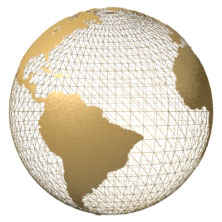| GigaPackets |
Toll Free Support: (888) 848-8749 |
|
Fixed Wireless Access

Managed SDN & SD-WAN
Dark Fiber - Wavelength Service
Comparing IP Transit, Peering and Dedicated Internet Access
How you connect to the Internet depends on the size of your network.By John Shepler
We live in a world of networks and networks of networks. The Internet is the ultimate example of networks upon networks upon networks. All of these networks need some way to communicate. For that, you have the choice of IP transit or peering.
It's Not One Big Network After All
Network to network communication would be unnecessary if the Internet was constructed the way most people envision it. When we think of the Internet, we think of one giant network that links everyone to everyone. It generally works that way for the end user, but the notion of a monolithic universal network is an illusion. Look inside the Internet and you’ll find it to be a collection of large, medium and small networks that all work together to get packets from one point to another. Let’s see what that takes.Tier 1Networks
At the top of the heap are Tier 1 networks. These are huge international IP networks that have points of presence in key locations around the world. Tier 1 networks are indeed the superhighways of the Internet. But like all highway systems, they don’t go everywhere. In order to create an Internet, you need to connect these superhighways together.About Peering
The connection process is called peering. The name suggests that this is a connection between equals or peers. That’s exactly right. Huge networks have huge amounts of traffic. If two of these networks peer to exchange traffic on an equal basis, then each network effectively doubles its reach. Network A has access to all the customers on Network B and vice versa.Settlement Free Peering
Tier 1 networks peer on a settlement free basis. In other words, the networks are interconnected via high capacity routers and the traffic flows back and forth at will. Settlement free means that there are no toll booths at the border. Neither network pays the other because they are getting equal value through peering.How Tier 2 Networks Connect
Not all networks are the same size. Smaller networks, called Tier 2, have less capacity and less reach than Tier 1 networks. Tier 1 networks aren’t about to peer with Tier 2 networks at no charge because the smaller network would be getting a lot more value from the arrangement than the larger one. What Tier 2 networks can do is ban together and peer among themselves to create a much larger entity that can compete with those Tier 1 networks. If they want access to the Tier 1 networks, they can pay a settlement charge based on the traffic imbalance. That charge is called IP transit.Peering vs IP Transit
Internet Service Providers have a choice when it comes to accessing the Internet. They can spend the capital and maintenance cost to build out their networks to the point where they can peer with other large networks, or they can just purchase IP transit services from a large network and avoid the investment in equipment and personnel.Do You Have An ASN?
Very small networks or medium size companies with their own internal networks will choose to buy Dedicated Internet Access rather than IP transit. You need to be a network operator with an assigned AS or Autonomous System number (ASN) that identifies each network on the Internet in order to qualify for IP Transit services. Some large organizations with connections to multiple networks may fit this definition, as well as large scale ISPs.When DIA Makes Sense
Everyone else, from local WISPs (Wireless Internet Service Providers) to SMBs (Small to Medium Size Businesses) simply purchases Dedicated Internet Access by the Mbps or Gbps of bandwidth. Operation of the Internet is left to those networks who specialize in that service.Find Fiber Optic Bandwidth Services Now
Optical carrier services, including Fast Ethernet & Gigabit Ethernet over Fiber, SONET, Wavelengths, Dark Fiber and other high speed low latency digital line services, including Managed SDN Software Defined Networking and SD-WAN, for commercial business and organizational applications. Find out what network services and pricing are available now for your commercial business building anywhere in the U.S. Simply call 1-888-848-8749 or use this handy form...
Fiber Bandwidth & Cloud Services Inquiry
Thank you for your interest. A technology services expert will be in touch soon. Please provide accurate phone & email contact information or call toll free for support anytime at 1-888-848-8749. All information you provide will be used only to support your inquiry.
<
|